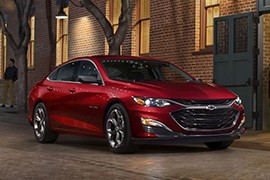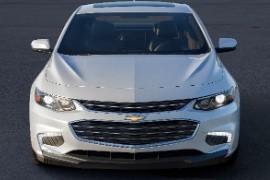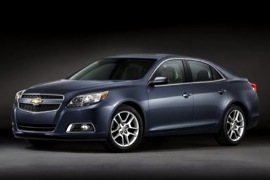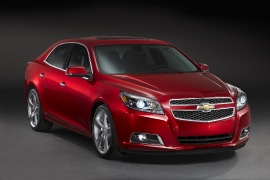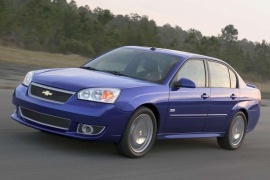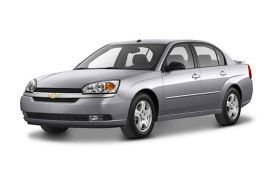CHEVROLET Malibu Models/Series Timeline, Specifications & Photos
First production year: 1996
Engines: Gasoline, Hybrid gasoline, Hybrid, Ethanol
The ninth generation of the Chevrolet Malibu was introduced in 2015 at the New York Motor Show and it was updated in 2018 for the 2019 model year.
Chevrolet did badge engineering since forever. In Europe, Opel and Vauxhall are one example. It was the same situation with other cars that crossed the Atlantic and received different names. One good example was the 2015 Malibu, which was an Opel Insignia with some aesthetical and technical improvements.
The facelifted version featured a new front fascia. The Chevrolet bow-tie was installed on a new chrome bar. A bigger lower grille was installed on the 2019 Malibu. A new signature LED lights for the DRL was installed in the front apron. The headlights were available with LED technology as well. The back of the car was slightly changed, but not significant for the LS trim level, but different for the LT, which featured LED taillamps. There was a new set of 18” light-alloy wheels fitted on the new RS trim level, which offered a sportier look.
Inside, the new 8” touch-screen was fitted as standard for the entire range. Another comfort feature that was changed was the access in the cabin. The 2019 Malibu, in LS trim, didn't feature unlock buttons on the exterior door handles.
The biggest changes came under the hood. The base engine, a 1.5-liter turbocharged unit, was mated to a CVT instead of a 6-speed auto as the non-facelifted version. The Premier trim level received a 2.0-liter turbocharged engine, paired to a 9-speed auto.
In 2015, at the New York Auto Show, Chevrolet unveiled the 2016 Malibu. It was based on the European platform of the Opel Insignia, but with a completely new design.
The Malibu had a long history in the GM portfolio. In 2015 the American company announced that the Malibu hit the 10 million cars sold worldwide since 1964 when the Malibu was introduced to the market. The ninth-generation had a difficult task to keep the name going on a very crowded market of mid-size sedans.
The Malibu used the same design language and similar cues with the larger Impala. Its sleek look and raked A-pillars placed the car into the sport-sedan segment. All the aerodynamic changes were made for a better fuel-efficiency, and not for high-performance. To lower the drag coefficient, the car was fitted with active shutters for the grille for the LS and TS trim levels. The upper trim level, named Premium, featured LED taillights.
Due to its long wheelbase, the 2016 Malibu offered more interior room than its predecessor. Inside the cabin, the car-maker installed new equipment including an industry-first „teen-assistant”. That could be controlled by a parent to limit or check speed or driver behavior.
The Malibu was fitted as standard with a small, 1.5-liter, turbocharged engine. It offered the same performances as a naturally aspirated 2.5-liter unit, but with a better fuel-efficiency. The top model was the Hybrid version, but that was not so well received by the market and it was cut from the production lines in 2020.
As one of the biggest suppliers of fleet vehicles, Chevrolet introduced the Malibu Eco version in 2011 at the New York Auto Show.
The Malibu Eco was the version that provided a better fuel efficiency than the rest of the range. It boasted up to 38 mpg (6.2 l/100 km) highway mileage, which was impressive for its segment, especially for a gasoline-fueled vehicle. General Motors built the eighth generation of the Malibu on the same Epsilon II SWB platform as the Buick Regal and the European Opel/Vauxhall Insignia.
In order to achieve such a performance, the carmaker installed underbody aerodynamic enhancements. Moreover, the car featured electronically-controlled shutters, which closed the front lower grille at higher speeds. Thus, the airflow was diverted on the sides, decreasing the ground effect. Its cab-forward design with fluid lines and very raked windshield lowered the car's drag resistance.
Inside, the cabin provided enough room for five adult passengers, although the tall center tunnel that crossed the car from front to back affected the rear seat's middle occupant legroom. At the front, GM prepared a dashboard with a center stack tilted toward the driver, where the infotainment system took the upper side. The automatic transmission gear selector mounted on the center console sported an elegant styling, thanks to the chromed trims around it.
But the most important difference when compared to the rest of the Malibu range was in the technical department. The 2.4-liter inline-four engine was mated to a six-speed automatic gearbox and helped by a 15 kW starter-generator and a 115 V lithium-ion battery pack.
The eight-generation of the Chevrolet Malibu was launched in 2012 as a 2013 model. It featured a new front fascia and it set a new direction toward the mid-size sport sedans.
The Malibu history goes back to the first generation in 1964 when it was available in four body shapes: sedan, station-wagon, coupe, and convertible. Fast forward to 1997 and the Malibu reached its fifth generation after almost 15 year of absence on the market. The model was front-wheel-drive instead of rear-wheel-drive as before.
The 2013 model was not that much longer than the 1997 model, but it was greatly improved. Its design evolved into a much rounded bodywork with a grille split in two parts by a horizontal line where the classic bow-tie badge was installed. Prolonged headlights and sculptured side panels led to an image of a bigger car. In the rear, it featured Camaro-inspired LED dual-element taillamps.
The Malibu interior featured an all-new dual cockpit design that created an inviting, roomy and comfortable environment. The increased width of the vehicle led to a more spacious cabin. The Malibu featured metallic, chrome or wood accents located around the shifter, surrounding the center stack, around the instrument cluster and on doors and the steering wheel.
For the engine compartment, depending on the market, it was available with engines ranging from a small, turbocharged, 1.5-liter unit up to a 3.0-liter V6. It was available with either a 6-speed manual or a 6-speed automatic.
Chevrolet introduced the seventh generation of the Malibu in 2008 and built it on the same platform as the Pontiac G6 and the European Opel/Vauxhall Insignia.
The bow-tie brand needed a gamechanger to counteract the drop in sales. Once a respectable name on the market, Chevrolet struggled to increase its car sales via various incentives offered to the customers, and the world financial crisis was just begun.
When it started developing Malibu, the American carmaker aimed directly at the Toyota Camry and the Honda Accord. While it was longer by 2.6" (66 mm) than the former, it was shorter than the latter by 2.3" (58 mm). Its long wheelbase made and the cab-forward design matched the customers' preferences, but the rental car companies still preferred it. Its elliptic, swept-back headlights created a dynamic image of the mid-size Malibu. The front grille sported a wide horizontal slat for the golden bow-tie badge and a wrapped-around plastic bumper with an integrated lower apron and side-scoops. From its profile, the Malibu revealed a wide C-pillar, resembling other luxury cars from the past. Its raked-forward windscreen and short trunk lid.
Inside, Chevrolet installed a wide dashboard that sported a three-dial instrument cluster in a binocular style, with a center-mounted speedometer flanked by the tachometer and the fuel and coolant temperature gauges. Its multi-buttons steering wheel controlled the audio system and the onboard computer functions. Thanks to the long wheelbase, the Malibu offered enough room on the rear seats for three adults.
Under the hood, depending on the trim level, Chevrolet installed either an inline-four or a V-6 powerplant paired with a four, or six-speed automatic, respectively. Unlike its European sibling, it was available exclusively with a front-wheel-drive system.
Chevrolet introduced the SS badge on the Impala '61, and ever since, it attached that "Super Sport" plate on many performance car versions, including on the fleet-oriented Malibu.
While the Chevrolet Malibu was more of a salesman or car-rental choice. The bow-tie brand tried to expand the range with an SS version, produced in both body versions: the Malibu and the Malibu Maxx (hatchback) built on the same platform as the Pontiac G6 and the European Vauxhall/Opel Vectra.
The design department installed a new front fascia for the SS version. The headlights were similar to those from the regular model, but the black mesh-grille featured a chromed surrounding and the bow-tie gold badge in the middle. On the lower side of the apron, the carmaker installed a broad grille and two side scoops for the fog lights. Moreover, the four-door sedan sported a small lip spoiler on the trunk's lid and dual chromed exhaust under the bumper.
Inside, everything was black. Its sport bucket seats with high bolstering gave a clue about the car's performance, and the three-spoke steering wheel just confirmed it. Inside the instrument cluster, the carmaker installed a wide speedometer in the middle between the tachometer and the fuel and temperature gauges. Chevrolet included the "Malibu" lettering on the right dial to remind the driver what car he or she was driving. The bolstered bucket seats provided some side support to prevent its occupants from sliding during high-speed cornering. The Malibu SS had the power to go way faster than a regular econobox found in most fleet vehicles.
Under the hood, GM installed a choice of two engines with a 3.9-liter displacement with variable valve timing, which produced 243 hp. In addition, the carmaker paired a four-speed automatic transmission as standard on the SS version.
The Malibu nameplate had its origins in 1964 when it was a top trim level for the Chevelle, but that was long gone. So by 2003, when Chevrolet introduced the sixth generation of it, it was already just a mid-size vehicle built mostly for fleet owners.
General Motors looks like it didn't want to spend too much on the development of the 2004 Malibu. Thus, it used the Epsilon platform shared with the European Opel/Vauxhall Vectra, the Italian Fiat Croma, and the Pontiac G6. Even though it was available with some unique versions, such as the SS.
Malibu's problem was not exactly that GM didn't want to spend too much on its development, but it showed that through the car's bland design. At the front, the grille was split in two by a horizontal slat that sported the bow-tie badge. In its first two years, that was chromed, but after 2006 Chevrolet dropped that, favoring a body-colored one. Its look resembled the European Vectra C, and yet, there were different quarter panels and fenders. The wide trunk lid featured the third stoplight, which was another budget-friendly solution.
Chevrolet made the Malibu in a few trim levels, starting with a very basic version that featured mediocre plastic panels and basic amenities. It was the kind of vehicle preferred by salespeople and rental companies. Still, it could be a very useful family car thanks to its low running costs. Moreover, it offered a large enough trunk for a cross-country trip.
Under the hood, GM installed the 2.2-liter gasoline engine for the base trim level but didn't forget to offer an SS version powered by a punchy, 3.9-liter V6.
GM dug into its nameplates box and found the Malibu after more than a decade since the last third-gen model rolled-out from the assembly lines and revived it in 1996 with a new model.
While the Malibu nameplate was not used since 1983, customers didn't forget it. After all, it's an exotic destination, even if the car was not. It played in the mid-size sedan segment against Toyota Camry, Honda Accord, or Ford Taurus.
Chevrolet tried to play it safe with the Malibu and designed it with soft lines. Its horizontal headlights sported rounded corners, flanking the four-slat grille with a chromed line at the top. The fog lights were standard only on the top trim level. Its body-colored door-handles and mirrors were standard across the range, which comprised two trim-levels. In the back, the sloped windscreen and tall trunk gave the vehicle a cab-forward design with a dynamic look but not aggressive.
Inside, the customers found two choices of trims: Base and LS. The leather bucket seats were fitted as an option. Chevrolet installed an AM/FM radio as standard for the former trim level and a radio-cassette player for the latter. The dashboard and instrument panel layout was friendly and easy to read and understand, with large dials for the speedometer and tachometer.
Under the hood, the Base level received a standard 2.4-liter inline-four, while the LS version received the 3.1-liter V-6 unit. Both were paired to a four-speed automatic transmission. The Malibu offered four-wheel anti-lock brakes as standard for the entire range and dual-airbags for the safety systems.
